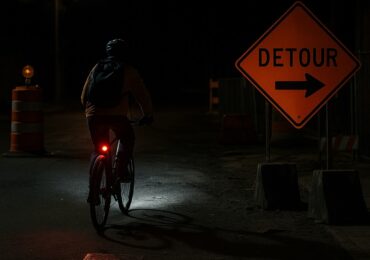You roll out after work, only to find your usual bike lane closed. The detour sign points into a side street that looks more shadow than road. Your eyes strain, your pace drops, and drivers behind you get impatient. Low light tricks your depth perception, flattening everything. A pothole reads as a stain, a gravel patch looks like dry pavement. Construction crews often set signs for daylight, not night. Signals go dark. Reflectors fall off barriers. If you crash, the crew will be gone by morning. If the worst happens, get legal advice after a serious bike accident, but let’s aim to avoid that ride to the ER.

Why Low-Light Detours Are Risky
Night riding changes both physics and psychology. Your pupils open, but your eyes need more time to adjust after each headlight glare. Contrast drops, so edges blur. Depth cues fade so that a trench can look shallow until your front wheel drops. Your headlight may only show 40 to 60 feet of usable detail. At 12 to 15 mph, that distance disappears fast.
Drivers also expect bikes to be in the usual lanes. A last-minute detour puts you where they do not look. Poor signage compounds it. A single cone with a paper sign is not enough when shadows swallow the message. Temporary controls, like portable stop signs or flagger instructions, often fail at night. Some crews cut lighting to save power or leave signal heads in flash mode, which confuses everyone.
Hidden Hazards You Don’t See Until It’s Too Late
These are the traps that appear at the last second:
- Loose gravel that rolls under skinny tires.
- Steel plates that turn slick with dew or oil. Wet metal reads like asphalt in low beams.
- Potholes and trenches with no beveled edges.
- Unmarked barriers and fencing with missing reflectors.
- Parked machinery is crowding the shoulder or the full lane.
- Curb lips, raised utility covers, and cable ramps with no paint.
- Temporary tape lines that vanish under glare.
- Turned-off or mis-timed signals, leaving you in no man’s land.
- Detour arrows pointing into oncoming traffic or toward dead ends.
Picture your light finding a black plate at the last instant, your front tire skating sideways. Or a fence foot jutting into the lane, ankle high and invisible until your pedal clips it. That is how crashes happen on quiet streets.
How to Protect Yourself Tonight
- Plan a better-lit alternate route. Choose arterials with working streetlights over dark cut-throughs. A few extra blocks can save a crash.
- Slow down. Night speed should match your headlight’s stopping distance, and if you cannot stop within the beam, back it off.
- Upgrade your lighting. Run an intense front light, 600 to 1000 lumens, angled to light the pavement ahead without blinding. Use a steady beam to see and a secondary flash to be seen. Use a bright rear light with a daytime flash mode.
- Add reflectivity where it moves. Ankle bands, heel reflectors, and wheel stripes pop in headlights and mark you as a person, not clutter.
- Communicate early and clearly. Big, deliberate hand signals help drivers understand your path through a weird detour. Make eye contact. Use your voice or a bell when you pass.
- Take the lane when needed. If debris or cones squeeze the edge, control the travel lane so no one tries a close pass. Hold a predictable line.
- Keep your ears open. Skip headphones so you catch engine noise, tires on gravel, or a backup alarm.
- Ride with a buddy when you can. Two lights, two sets of eyes, and a bigger silhouette.
- Scan for telltales. Fresh utility cuts have sandy edges. A change in pavement sound hints at a plate. Shiny equals slippery.
- Document danger. Stop in a safe spot and grab photos that show location, missing reflectors, or dead signals. Note the contractor’s name on the sign. Report it to the city’s hotline or 311 app. Share with your local bike group to warn others.
What Cities and Crews Must Do Better
Detours should be safe at night, not just checked at noon. Agencies and contractors can fix the most significant risks with simple steps.
- Provide temporary lighting where bike lanes or crosswalks shift.
- Use reflective barricades and drums with working lights, not dull plastic.
- Place clear, consistent signage before and through the work zone, not just at the hole in the ground.
- Build protected detour lanes with sturdy separation, not a few cones. Keep them swept.
- Lower night speed limits near work zones and enforce them.
- Run after-dark safety audits. Walk and ride the detour at night, in the rain, and fix what fails.
- Post simple maps in advance of closures so riders can choose safer routes without surprise.
Conclusion
You deserve a route that does not gamble with your life after sunset. Dark detours hide edges, mute contrast, and push you into places drivers do not expect to go. Protect yourself with brighter lights, slower speeds, clear signals, and routes that shine. Ride with a friend when you can, and report dangerous spots so the next rider doesn’t pay for someone else’s shortcut. Push your city to light and mark detours as if it were their family riding through. If harm still finds you, get legal advice after a serious bike accident, and keep pressing for safer streets tomorrow.